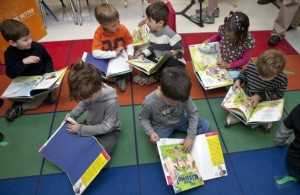Former Principal Speaks about White Families and DCPS

Wendy Carlson/Getty Images
A Washington Post profile of an outgoing D.C. Public Schools elementary school principal provides some insight into the racial divisions in school enrollment. Bill Kerlina left his post as principal of Phoebe Hearst Elementary School, located in the mostly white Ward 3, due to what he calls the dysfunction of the school system.
Hearst’s student body was comprised of mostly out-of-boundary black students. A few days before he quit, Kerlina received a positive evaluation from an instruction superintendent who asked him why there were not more white families at the school. Kerlina wrote back to the superintendent to lay out “a taxonomy of Northwest parents in an effort to show the hurdles to recruiting more neighborhood families:”
The well-to-do private school families, “the majority” in the neighborhood, he wrote, were a lost cause. “I have not courted them and do not plan to do so, since they will never consider DCPS,” Kerlina wrote.
Next were those afflicted with what he called “Murch and Eaton envy,” a reference to two much-in-demand Northwest elementary schools. He told Alexander that six in-boundary families had enrolled at Hearst for the fall but pulled out when slots at Eaton and Murch opened up.
“I have been working with these families but it’s hard to change a culture of thoughts and ideas,” he wrote.
Finally, he wrote, there were families with racial prejudices. He said this conclusion came from a series of conversations he had with prospective neighborhood parents “that delicately asked about the number of out-of-boundary families and made reference to the ‘diversity’ of Hearst.”
“They will never come to Hearst because of the number of out-of-boundary black families,” he wrote.
One way to lure neighboring families — restricting the number of out-of-boundary seats — would be a “horrible mistake,” Kerlina wrote, as “the diversity at Hearst is what makes it a great school.”
The student body of DCPS remains majority black. Many black parents have been skeptical of efforts to diversify schools and restrict out-of-boundary seats; those who can’t afford to send their children to private school and live near low-performing schools have relied on being able to enroll their children in well-performing schools outside of their wards. Schools like Hearst. Given that, Kerlina’s description of some white families in the neighborhood does little to quiet that skepticism.




